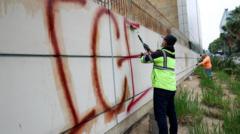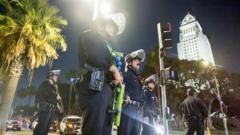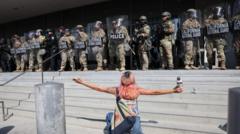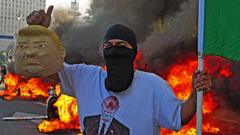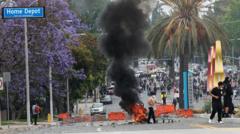Since taking office, Trump’s administration dramatically ramped up ICE operations, targeting a wide range of undocumented migrants, leading to significant backlash and protests nationwide.**
ICE Arrests Under Trump's Administration: A Closer Look**

ICE Arrests Under Trump's Administration: A Closer Look**
Exploring the impact of Trump's immigration enforcement, focusing on the profiles of those arrested by ICE, including criminals, tourists, and student activists.**
On the campaign trail, Donald Trump promised a comprehensive immigration crackdown, vowing to initiate "the largest deportation programme of criminals in the history of America" on his first day in office. This pledge resonated with many Americans, including legal immigrants, who expressed concerns about undocumented individuals entering the country unlawfully. However, since assuming the presidency, Trump's administration has expanded its focus from purely targeting criminals to including migrant workers, students, and even tourists with visa complications.
For nearly five months, Trump's immigration enforcement actions went largely unchallenged until protests erupted in Los Angeles over escalated raids in workplaces. This scrutiny begs the question: who are the individuals caught in the crossfire of these operations, and who else is being targeted by the administration?
Under Trump's leadership, the President has frequently boasted about declining border crossings alongside a surge in arrests. Recent data from early June indicates that over 51,000 undocumented migrants were held in ICE detention, the highest number recorded since September 2019. While the administration aimed to scale arrests to about 3,000 a day, an alarming statistic emerged: 44% of those detained had no prior criminal record besides illegal entry into the U.S.
Tensions reached a boiling point with a series of arrests in Los Angeles that resulted in 118 detentions, including five reputed gang members, as claimed by the Department of Homeland Security (DHS). ICE categorized those arrested as "the worst of the worst," though reports indicate many had clean records. For example, the parents of a 23-year-old Zapotec man shared that their son had no criminal history when he was detained outside a clothing store.
Federal officials have labeled these arrests as "collateral" consequences of law enforcement. Marco Rubio has highlighted that over 300 foreign students had their visas revoked, while deportations continued at pace for various nationalities, including Cubans and Haitians.
Tourists have also faced detainment, with notable cases including a Welsh citizen detained for 19 days due to a visa error, and Khaby Lame, a widely-recognized TikTok star, who was briefly held at a Las Vegas airport for overstaying his visa. Conditions in detention centers have drawn criticism from former detainees and advocates alike, citing inhumane treatment.
High-profile accounts from Central America revealed that over 250 alleged gang members, falsely accused by the government, have been sent to a mega-prison. Familial ties have been disrupted, and community members have pushed back, claiming innocent people are targeted based on superficial gang associations. An indicative case is that of Kilmar Abrego Garcia, who was wrongfully deported yet later returned to face charges.
International students involved in political protests have also felt the heavy hand of the administration, with many having valid immigration statuses yet finding themselves facing detention or deportations for their activism. Advocacy groups have reported a rise in arrests, asserting that immigration authorities are overstepping legal boundaries.
Among those impacted are green card holders like Mahmoud Khalil, who faces deportation following his participation in protests. Another tragic case includes Tufts University student Rumeysa Ozturk, who was held for six weeks after her student visa was revoked.
Despite widespread concern and criticism, ICE has defended its actions, maintaining that the revocation of visas and detentions are lawful steps necessary to address perceived threats. The complex dynamics of immigration enforcement during Trump’s administration reveal a fraught landscape, where lawful migrants often find themselves caught in a web of aggressive immigration policy.





